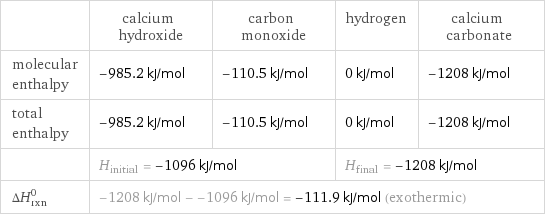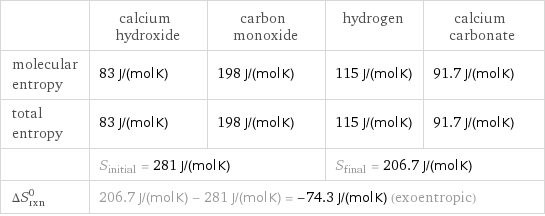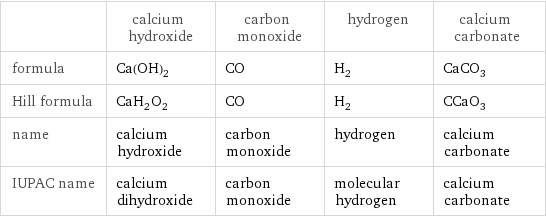Input interpretation

Ca(OH)_2 calcium hydroxide + CO carbon monoxide ⟶ H_2 hydrogen + CaCO_3 calcium carbonate
Balanced equation

Balance the chemical equation algebraically: Ca(OH)_2 + CO ⟶ H_2 + CaCO_3 Add stoichiometric coefficients, c_i, to the reactants and products: c_1 Ca(OH)_2 + c_2 CO ⟶ c_3 H_2 + c_4 CaCO_3 Set the number of atoms in the reactants equal to the number of atoms in the products for Ca, H, O and C: Ca: | c_1 = c_4 H: | 2 c_1 = 2 c_3 O: | 2 c_1 + c_2 = 3 c_4 C: | c_2 = c_4 Since the coefficients are relative quantities and underdetermined, choose a coefficient to set arbitrarily. To keep the coefficients small, the arbitrary value is ordinarily one. For instance, set c_1 = 1 and solve the system of equations for the remaining coefficients: c_1 = 1 c_2 = 1 c_3 = 1 c_4 = 1 Substitute the coefficients into the chemical reaction to obtain the balanced equation: Answer: | | Ca(OH)_2 + CO ⟶ H_2 + CaCO_3
Structures

+ ⟶ +
Names

calcium hydroxide + carbon monoxide ⟶ hydrogen + calcium carbonate
Reaction thermodynamics
Enthalpy

| calcium hydroxide | carbon monoxide | hydrogen | calcium carbonate molecular enthalpy | -985.2 kJ/mol | -110.5 kJ/mol | 0 kJ/mol | -1208 kJ/mol total enthalpy | -985.2 kJ/mol | -110.5 kJ/mol | 0 kJ/mol | -1208 kJ/mol | H_initial = -1096 kJ/mol | | H_final = -1208 kJ/mol | ΔH_rxn^0 | -1208 kJ/mol - -1096 kJ/mol = -111.9 kJ/mol (exothermic) | | |
Gibbs free energy

| calcium hydroxide | carbon monoxide | hydrogen | calcium carbonate molecular free energy | -897.5 kJ/mol | -137 kJ/mol | 0 kJ/mol | -1129 kJ/mol total free energy | -897.5 kJ/mol | -137 kJ/mol | 0 kJ/mol | -1129 kJ/mol | G_initial = -1035 kJ/mol | | G_final = -1129 kJ/mol | ΔG_rxn^0 | -1129 kJ/mol - -1035 kJ/mol = -94.6 kJ/mol (exergonic) | | |
Entropy

| calcium hydroxide | carbon monoxide | hydrogen | calcium carbonate molecular entropy | 83 J/(mol K) | 198 J/(mol K) | 115 J/(mol K) | 91.7 J/(mol K) total entropy | 83 J/(mol K) | 198 J/(mol K) | 115 J/(mol K) | 91.7 J/(mol K) | S_initial = 281 J/(mol K) | | S_final = 206.7 J/(mol K) | ΔS_rxn^0 | 206.7 J/(mol K) - 281 J/(mol K) = -74.3 J/(mol K) (exoentropic) | | |
Equilibrium constant
![Construct the equilibrium constant, K, expression for: Ca(OH)_2 + CO ⟶ H_2 + CaCO_3 Plan: • Balance the chemical equation. • Determine the stoichiometric numbers. • Assemble the activity expression for each chemical species. • Use the activity expressions to build the equilibrium constant expression. Write the balanced chemical equation: Ca(OH)_2 + CO ⟶ H_2 + CaCO_3 Assign stoichiometric numbers, ν_i, using the stoichiometric coefficients, c_i, from the balanced chemical equation in the following manner: ν_i = -c_i for reactants and ν_i = c_i for products: chemical species | c_i | ν_i Ca(OH)_2 | 1 | -1 CO | 1 | -1 H_2 | 1 | 1 CaCO_3 | 1 | 1 Assemble the activity expressions accounting for the state of matter and ν_i: chemical species | c_i | ν_i | activity expression Ca(OH)_2 | 1 | -1 | ([Ca(OH)2])^(-1) CO | 1 | -1 | ([CO])^(-1) H_2 | 1 | 1 | [H2] CaCO_3 | 1 | 1 | [CaCO3] The equilibrium constant symbol in the concentration basis is: K_c Mulitply the activity expressions to arrive at the K_c expression: Answer: | | K_c = ([Ca(OH)2])^(-1) ([CO])^(-1) [H2] [CaCO3] = ([H2] [CaCO3])/([Ca(OH)2] [CO])](../image_source/4aab49c08a0985a8ecd3de7c1937d3e1.png)
Construct the equilibrium constant, K, expression for: Ca(OH)_2 + CO ⟶ H_2 + CaCO_3 Plan: • Balance the chemical equation. • Determine the stoichiometric numbers. • Assemble the activity expression for each chemical species. • Use the activity expressions to build the equilibrium constant expression. Write the balanced chemical equation: Ca(OH)_2 + CO ⟶ H_2 + CaCO_3 Assign stoichiometric numbers, ν_i, using the stoichiometric coefficients, c_i, from the balanced chemical equation in the following manner: ν_i = -c_i for reactants and ν_i = c_i for products: chemical species | c_i | ν_i Ca(OH)_2 | 1 | -1 CO | 1 | -1 H_2 | 1 | 1 CaCO_3 | 1 | 1 Assemble the activity expressions accounting for the state of matter and ν_i: chemical species | c_i | ν_i | activity expression Ca(OH)_2 | 1 | -1 | ([Ca(OH)2])^(-1) CO | 1 | -1 | ([CO])^(-1) H_2 | 1 | 1 | [H2] CaCO_3 | 1 | 1 | [CaCO3] The equilibrium constant symbol in the concentration basis is: K_c Mulitply the activity expressions to arrive at the K_c expression: Answer: | | K_c = ([Ca(OH)2])^(-1) ([CO])^(-1) [H2] [CaCO3] = ([H2] [CaCO3])/([Ca(OH)2] [CO])
Rate of reaction
![Construct the rate of reaction expression for: Ca(OH)_2 + CO ⟶ H_2 + CaCO_3 Plan: • Balance the chemical equation. • Determine the stoichiometric numbers. • Assemble the rate term for each chemical species. • Write the rate of reaction expression. Write the balanced chemical equation: Ca(OH)_2 + CO ⟶ H_2 + CaCO_3 Assign stoichiometric numbers, ν_i, using the stoichiometric coefficients, c_i, from the balanced chemical equation in the following manner: ν_i = -c_i for reactants and ν_i = c_i for products: chemical species | c_i | ν_i Ca(OH)_2 | 1 | -1 CO | 1 | -1 H_2 | 1 | 1 CaCO_3 | 1 | 1 The rate term for each chemical species, B_i, is 1/ν_i(Δ[B_i])/(Δt) where [B_i] is the amount concentration and t is time: chemical species | c_i | ν_i | rate term Ca(OH)_2 | 1 | -1 | -(Δ[Ca(OH)2])/(Δt) CO | 1 | -1 | -(Δ[CO])/(Δt) H_2 | 1 | 1 | (Δ[H2])/(Δt) CaCO_3 | 1 | 1 | (Δ[CaCO3])/(Δt) (for infinitesimal rate of change, replace Δ with d) Set the rate terms equal to each other to arrive at the rate expression: Answer: | | rate = -(Δ[Ca(OH)2])/(Δt) = -(Δ[CO])/(Δt) = (Δ[H2])/(Δt) = (Δ[CaCO3])/(Δt) (assuming constant volume and no accumulation of intermediates or side products)](../image_source/6e0faae1d8b823b573a6de2058e6173c.png)
Construct the rate of reaction expression for: Ca(OH)_2 + CO ⟶ H_2 + CaCO_3 Plan: • Balance the chemical equation. • Determine the stoichiometric numbers. • Assemble the rate term for each chemical species. • Write the rate of reaction expression. Write the balanced chemical equation: Ca(OH)_2 + CO ⟶ H_2 + CaCO_3 Assign stoichiometric numbers, ν_i, using the stoichiometric coefficients, c_i, from the balanced chemical equation in the following manner: ν_i = -c_i for reactants and ν_i = c_i for products: chemical species | c_i | ν_i Ca(OH)_2 | 1 | -1 CO | 1 | -1 H_2 | 1 | 1 CaCO_3 | 1 | 1 The rate term for each chemical species, B_i, is 1/ν_i(Δ[B_i])/(Δt) where [B_i] is the amount concentration and t is time: chemical species | c_i | ν_i | rate term Ca(OH)_2 | 1 | -1 | -(Δ[Ca(OH)2])/(Δt) CO | 1 | -1 | -(Δ[CO])/(Δt) H_2 | 1 | 1 | (Δ[H2])/(Δt) CaCO_3 | 1 | 1 | (Δ[CaCO3])/(Δt) (for infinitesimal rate of change, replace Δ with d) Set the rate terms equal to each other to arrive at the rate expression: Answer: | | rate = -(Δ[Ca(OH)2])/(Δt) = -(Δ[CO])/(Δt) = (Δ[H2])/(Δt) = (Δ[CaCO3])/(Δt) (assuming constant volume and no accumulation of intermediates or side products)
Chemical names and formulas

| calcium hydroxide | carbon monoxide | hydrogen | calcium carbonate formula | Ca(OH)_2 | CO | H_2 | CaCO_3 Hill formula | CaH_2O_2 | CO | H_2 | CCaO_3 name | calcium hydroxide | carbon monoxide | hydrogen | calcium carbonate IUPAC name | calcium dihydroxide | carbon monoxide | molecular hydrogen | calcium carbonate